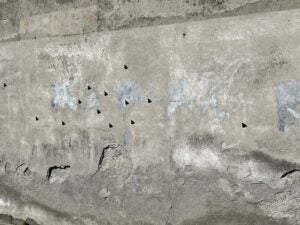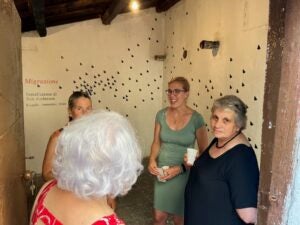KINGSTON, RI –August 19, 2024 – Ben Anderson, professor of three-dimensional art and sculpture, premiered his installation this past July in Italy. ‘Migration’ scatters 300 black vinyl monarch butterflies throughout the small town of Lago, nestled in the picturesque region of Calabria in the ‘toe’ of Italy’s boot.
Location became the beating heart of this installation because of Lago native Italo Scanga. Scanga was an Italian-born artist and educator who moved to America during World War II. He was known for his sculptures, ceramics, glass, prints, and paintings, working as a neo-Dadaist, neo-Expressionist, and neo-Cubist; his art was mostly created from found objects and/or ordinary objects.
Ben had the opportunity to study with Scanga as a graduate student at University of California, San Diego. Scanga always wanted to create a museum or gallery in his hometown, but passed away before making this dream a reality. In turn, Ben took it upon himself to see his friend and mentor’s wish come true.
 After meeting with town leaders, including the Mayor of Lago Enzo Scanga, Ben proposed an open ended installation of “vinyl monarch butterflies as metaphors for migration. I just love the fragility of the image of the creature and how it floats above human toil,” he said. Lago is an ancient town that has been gradually losing its population, as have many small southern Italian towns, due to migration of young people to the north, primarily for employment. This installation speaks to this human migration.
After meeting with town leaders, including the Mayor of Lago Enzo Scanga, Ben proposed an open ended installation of “vinyl monarch butterflies as metaphors for migration. I just love the fragility of the image of the creature and how it floats above human toil,” he said. Lago is an ancient town that has been gradually losing its population, as have many small southern Italian towns, due to migration of young people to the north, primarily for employment. This installation speaks to this human migration.
The project has been on his radar, working on and off for several years through a variety of mediums exploring the idea. Once the idea of the monarchs crystalized, he worked on 10 to 15 prototypes to test if his vision could realistically come to life in an unconventional space. As the project took shape, the idea of having 300 of these shadow-like creatures ebbing and flowing in and outside of city walls gave it a heartbeat.
Through many years of experience, Ben knew moving work to Europe is quite expensive – particularly if the work includes any large, heavy, and/or fragile objects of any kind. The beauty of this project, however, was its scale. All 300 butterflies could fit comfortably in a suitcase before they really took flight.
 Locals did not necessarily know what to expect as it was the first time the space had ever been treated like an exhibition space. They may have expected traditional paintings or sculptures, but the monarchs were subtle and very well received and the people of the town were personally familiar with the concept of migration. “I love that the project was so open-ended for people to interpret however they wanted. There was this sort of warm contemplation of the concept and idea of ephemerality,” said Ben.
Locals did not necessarily know what to expect as it was the first time the space had ever been treated like an exhibition space. They may have expected traditional paintings or sculptures, but the monarchs were subtle and very well received and the people of the town were personally familiar with the concept of migration. “I love that the project was so open-ended for people to interpret however they wanted. There was this sort of warm contemplation of the concept and idea of ephemerality,” said Ben.
As an artist, Ben identifies himself as a sculptor, but branching out and creating something outside of his typical medium sends an important message as an artist. And perhaps, most importantly, to his students. “I think visual art, contemporary art, is so open now, and the artists don’t necessarily think of themselves as, say, a painter or a sculptor, but more of as a visual artist. The idea of being designated to a silo of a medium as an artist is slowly going away. Students seem to adapt to different media very easily.”

